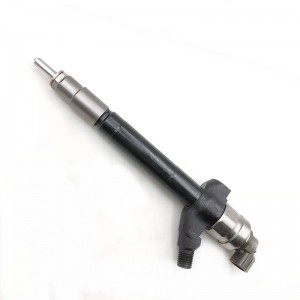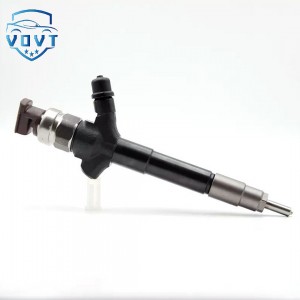High Quality Original New Common Rail Diesel Fuel Injector 23670-30010
Products Description
| Reference. Codes | 23670-30010 |
| Application | / |
| MOQ | 4PCS |
| Certification | ISO9001 |
| Place of Origin | China |
| Packaging | Neutral packing |
| Quality Control | 100% tested before shipment |
| Lead time | 7~15 working days |
| Payment | T/T, L/C, Western Union, Money Gram, Paypal, Ali pay, Wechat |
Optimization of rail pressure characteristics for high pressure common rail systems
Optimization of injector structural parameters
Optimization of injector structure parameters is the key means to reduce rail pressure fluctuation. Through orthogonal test and response surface method, the key parameters affecting the rail pressure fluctuation are identified: needle valve quality, needle valve guide range, control chamber volume and nozzle orifice. Needle valve mass has the most significant effect on rail pressure fluctuation, as shown in Fig. 2. When the needle valve mass increases from 2g to 5g, the amplitude of rail pressure fluctuation decreases from 8MPa to 4MPa, but continuing to increase the mass causes the fluctuation amplitude to rise. This is because a lighter needle valve responds faster but is prone to pressure oscillation, while a heavier needle valve increases the injection delay. The optimized needle valve mass is 5.2 g. The needle valve lead is optimized to 0.25 mm to reduce the pressure fluctuation inside the injector. The control chamber volume is increased to 12mm³, which improves the system damping, but it is too large to reduce the response speed. The nozzle aperture is optimized to 0.18mm, which minimizes the rail pressure fluctuation while ensuring sufficient atomization. Genetic algorithm is used for multi-objective optimization to obtain the Pareto optimal solution set. The selected parameter combination reduces the rail pressure fluctuation by 18.5% under the rated operating conditions and maintains the good injection characteristics. These optimized parameters provide an important reference for injector design.
Control strategy optimization
Control strategy optimization is the core of realizing accurate control of rail pressure. Based on the model predictive control (MPC) theory, a new closed-loop control algorithm for rail pressure is developed. The algorithm utilizes the system model to predict the future rail pressure changes, and solves the optimal control sequence in the rolling time domain. The control objective function consists of rail pressure tracking error, control volume change rate and fuel consumption, and the importance of each objective is adjusted by weighting coefficients. In order to adapt to the rapid change of engine conditions, an adaptive mechanism is introduced to dynamically adjust the parameters of the prediction model. As shown in Fig. 3, the optimized control strategy significantly improves the tracking accuracy of rail pressure. Under typical working conditions, the amplitude of rail pressure fluctuation is reduced from ±5MPa to ±2MPa, the overshooting amount is reduced by 50%, and the adjustment time is shortened by 30%. At the same time, by combining offline optimization and online adjustment, a three-dimensional rail pressure target map covering all working conditions is established. By applying the table checking and interpolation algorithm in ECU, the balance between computational efficiency and control accuracy is realized. In addition, the feed-forward compensation is introduced to improve the system's ability to suppress external disturbances. The optimized control strategy not only improves the rail pressure stability, but also increases the fuel economy by 2.8% and improves the emission index.























